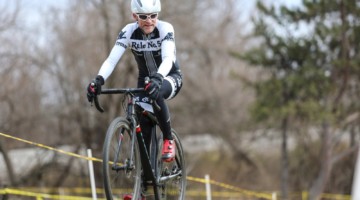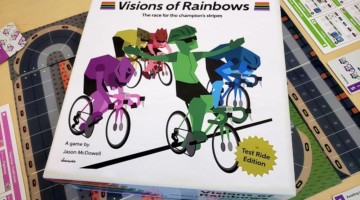Stephen Hyde had a big weekend in Rochester, winning Saturday’s three-up sprint against Jeremy Powers and Rob Peeters and finishing a close second behind Kerry Werner on Sunday. With Sunday’s Jingle Cross World Cup drawing close, Hyde is looking forward to representing the U.S. and his Cannondale p/b CyclocrossWorld team at the event where he finished a strong tenth in 2016, but he is also looking forward to riding for a team of a little different color.
Last winter, I chatted with Hyde for a story. During that interview, as a fellow ginger, I had to ask Hyde what it feels like to be a hero for red-headed cyclocross racers. It turns out, being a successful ginger cyclist is something Hyde takes very seriously, and he elaborated on the topic far more than I could have ever expected.
Hyde’s Groundbreaking Ryde in Hartford is an Inspiration for American Gingers
This past January in Hartford, Stephen Hyde was racing for his first U.S. National Championship in the lime green kit of his Cannondale Cyclocrossworld.com team. He was also seeking to bring glory to another kit and team: the red hair of Team Ginger.
Hyde’s legendary ride in Hartford and thrilling sprint across the finish line after he snapped off his derailleur hanger helped cement his legacy as one of the great American ginger ’cross racers next to six-time U.S. cyclocross national champion Alison Dunlap and four-time champion Don Myrah. Myrah last won the Elite National Championships in 1993 and Dunlap in 2003, so red-headed U.S. ‘crossers have been waiting for a new champion for over a decade.
Hyde has gladly stepped into that role, and when asked about the meaning of his accomplishment in the snow of Hartford, he was succinct:
“Groundbreaking.”
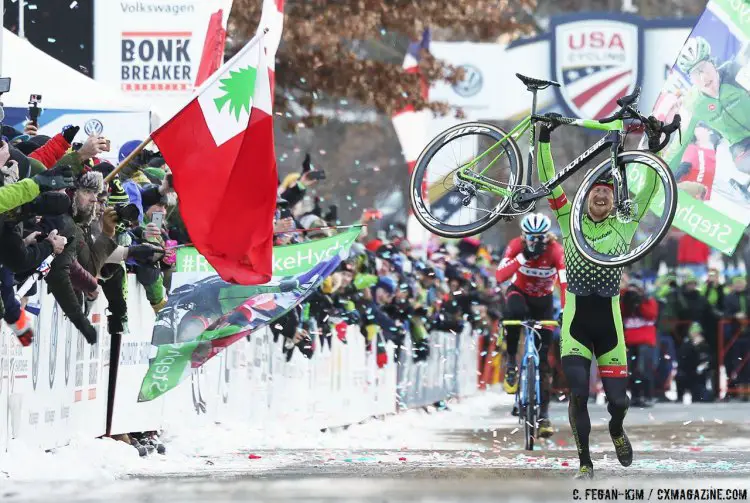
Stephen Hyde carries his bike across the finish line to win the 2017 U.S. Cyclocross National Championship in Hartford, CT. © C. Fegan-Kim / Cyclocross Magazine
The Hero Ginger Cyclists Need and Deserve
Life can sometimes be tough for the gingers of the world. Redheads represent less than two percent of the world’s population, and they are frequently fodder for jokes about carrot heads and the like. Ginger cyclists face the additional burden of carrying an ample supply of sunscreen in their kits and the possibility of not getting a lycra tan as a reward for their hours on the bike.
Fortunately, ginger ’crossers have had their share of ginger heroes to look to over the years. Before there was Katie Compton in U.S. cyclocross, there was Alison Dunlap. Dunlap won six national championships, the last in 2003 in Bend, and she also won the 2001 Mountain Bike World Championship.
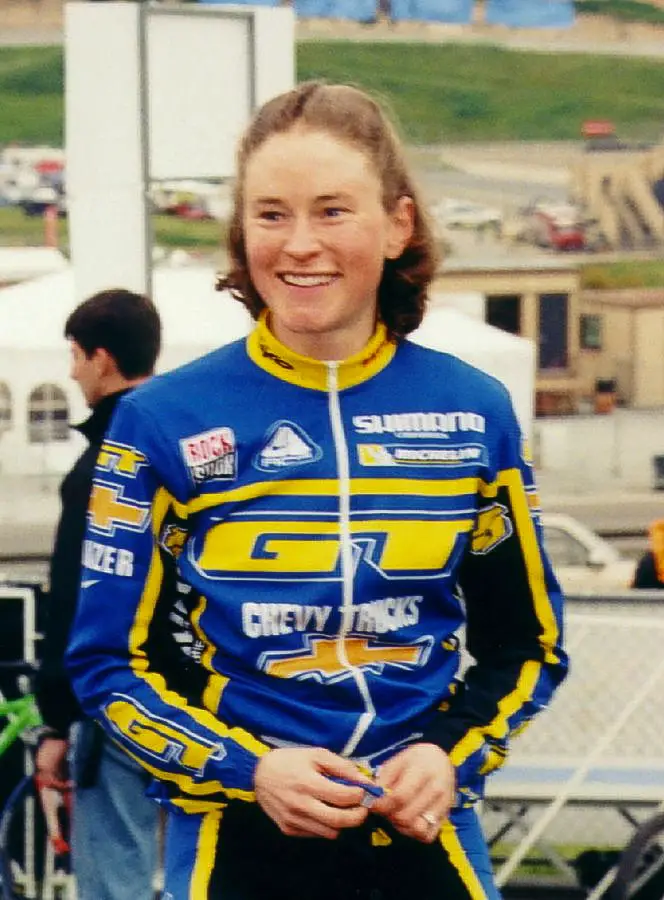
Alison Dunlap won U.S. Cyclocross Nationals six times. © James F. White, used under Creative Commons license CC BY-SA 3.0
Don Myrah won four national championships during his elite career (1989-1991, 1993) and medaled seven times. After a long break from cycling when life intervened, Myrah returned to racing cyclocross in 2007 and has since added three Masters national championships and three Masters world championships to his impressive list of accomplishments.
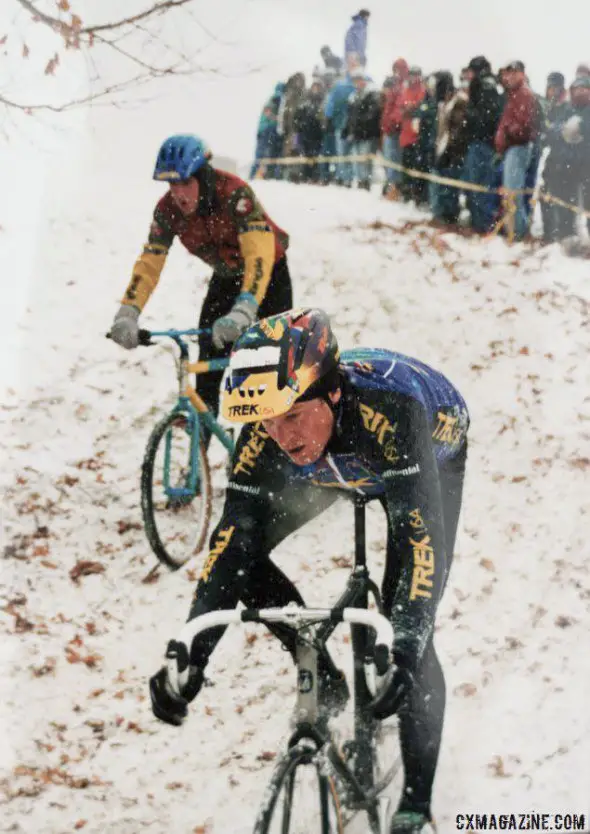
Don Myrah was the original U.S. red-headed cyclocross star, winning four national titles in the 80s and 90s. photo: ’95 Nats. © Cyclocross Magazine
Red-headed American cyclocross fans have had several recent heroes to look to for cycling gingsperation. Robert Marion and his majestic ginger beard have inspired the “Fear the Beard” cry, and singlespeed specialist Craig Ethridge has also been a fan favorite at races across the country.
These recently ginger cult heroes helped pave the way for gingerstar Stephen Hyde to establish himself in the upper echelon of American cyclocross riders and make a name for himself on the European circuit. Never one to back down from a challenge, Hyde welcomes the opportunity to represent Team Ginger on the cyclocross world stage, “Somebody has to do it, and I feel great,” he said. “It feels pretty good to be a successful ginger.”
A Ginger Cyclocross Advantage?
In cycling, any advantage a rider can get on their opponents can make a difference in a race. Riders turn themselves inside out to drop a few grams—thus making the previously-mentioned sunscreen reserve a double pain—or figure out the best new training regimen.
Hyde is well versed on the research about variants in the M1CR gene that create red hair and has found the science of being a ginger may have prepared him well for the December and January days spent racing in the dreary and bleak winters of the Low Countries.
“There are some scientific advantages to being a ginger and being in Europe,” said Hyde. “Let me lay this out there. Because of my fair skin-ness, right, low pigment, people with low pigment tend to convert sunlight into Vitamin D quicker. So in low sunlight areas, maybe, just maybe, I’m no scientist, but there might be the potential that I convert Vitamin D quicker than other athletes, therefore, I’ve climatized myself to low sunlight, aka Belgium and the Netherlands, and their rainy winters better.”
He continued, “Maybe I only need like an hour to the ten hours someone else needs to get the Vitamin D and therefore be happier. I don’t know. Total speculation. I hope it’s true. I’m using it as a super power.”
“Maybe I only need like an hour to the ten hours someone else needs to get the Vitamin D and therefore be happier. I don’t know. Total speculation. I hope it’s true. I’m using it as a super power.”
Science has also shown that gingers have a higher pain tolerance, which is a skill that should be a major advantage in a sport that revolves around athletes inflicting pain upon themselves and others. Hyde said that he is familiar with the studies and agrees, up to a point.
“I know that gingers require more anesthetic typically,” Hyde said about his knowledge of pain tolerance. “But you know, I find that I can inflict massive amounts of pain on myself and can do lots of things to myself that I would, I think a lot of people, just as an elite athlete, most people would not do things that elite athletes do to themselves. I find myself pushing myself a little harder, maybe that’s an advantage or not.”
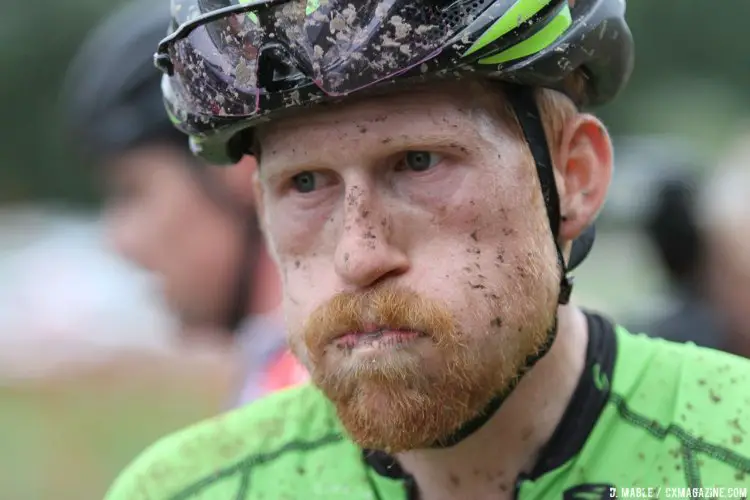
Stephen Hyde is no stranger to tolerating pain on the bike. 2016 Jingle Cross UCI C1, Day 3, Elite Men. © D. Mable / Cyclocross Magazine
There is catch, however. Said Hyde, “But have someone try to put an eye drop in my eye or something or give me a shot, and I’m like, Absolutely not. No one can do this to me. Even if you have someone pop zits on your back or something and it’s like, Absolutely not. No way. That hurts. What are you doing? This is painful.”
Hyde concluded, “But I love sitting behind the scooter with like my tongue on the handlebars or whatever.”
A Gingercross Rivalry Emerges
After rising to the pinnacle of American cyclocross, Hyde has turned his sights toward success on the world stage. He obviously wants to do well at the UCI World Cup and Hansgrohe Superprestige events, but he also has his attention focused on a race that is arguably more important: The Gingercross.
Hyde said his friend Mike and him have done some investigative work trying to identify fellow ginger cyclocross riders. Their search has proven difficult, with few gingers to be found on the professional cyclocross circuit.
Statistically, this is a curious finding. In the United States, 2 to 6% of the population is believed to have ginger hair, and percentages are similar across the continent of Europe—with the exception of Scotland and Ireland, which have, of course, a more crimson hue. Cyclocross is currently dominated by Belgians and the Dutch, so one might expect the Low Countries to have a low percentage of gingers among their respective populations. That assumption, however, would be incorrect.
The vaguely-sourced map in this story shows that the percentage of gingers in the Low Countries is about 4-6%, which is higher than both the overall European and world percentages, and thus a lack of gingers is not a plausible explanation for why there are so few ginger ’cross racers.
Fortunately for Hyde, his investigation did end up finding one fellow ginger cyclocross rider: Klaas Vantornout of Belgium.
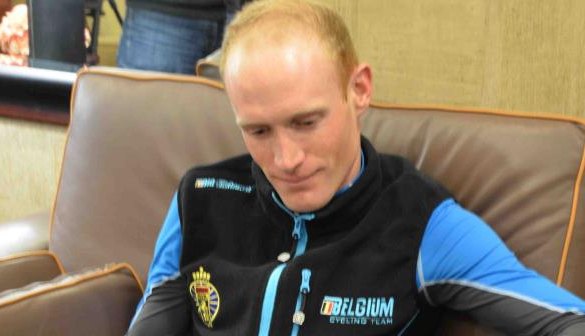
Stephen Hyde has his sights set on Klaas Vantornout as a Gingercross rival. © Cyclocross Magazine
Hyde talked about his investigative work, “I was trying to think, and the reason why I have kind of settled on Klaas as a ginger, is we were trying to figure out, my friend Mike and I, were trying to figure out if there were any successful gingers in cyclocross,” he said. “I think Klaas is it. I think we took votes on whether he is a ginger or not, and I think we decided yes. But I’m pretty stoked about it.”
“I think Klaas is it. I think we took votes on whether he is a ginger or not, and I think we decided yes.”
Since Hyde finally found a fellow ginger, it only made sense to establish a Gingercross rivalry with his soulless-mate. Said Hyde, “There’s one ginger, or pseudo-ginger, who I have kind of moved my sights on. I’ve beaten him a couple of times now … let’s say once or twice, and he is always kind of right in my striking distance, but Klaas Vantornout is a ginger. He has a little bit of a beard.”
Hyde conceded that Vantornout might not be 100% aware of the rivalry, but the Gingercross is a real thing whether he knows it or not. “Every time we go to the start line or I see him at the races I give him shit,” Hyde said. “I’m always like Bro, I’m watching you. I’m coming for you, Big Bird. I’m pretty sure he hates me. I’m positive he hates me. For many reasons. But, absolutely, I’m always like I will be the top ginger one day Klaas. I’m coming for you brother.”
One of the most recent editions of the Gingercross rivalry was covered in Cyclocross Magazine‘s race report from the 2016 World Cup at Namur, where Vantornout got the best of Hyde, finishing 10th to Hyde’s 19th.
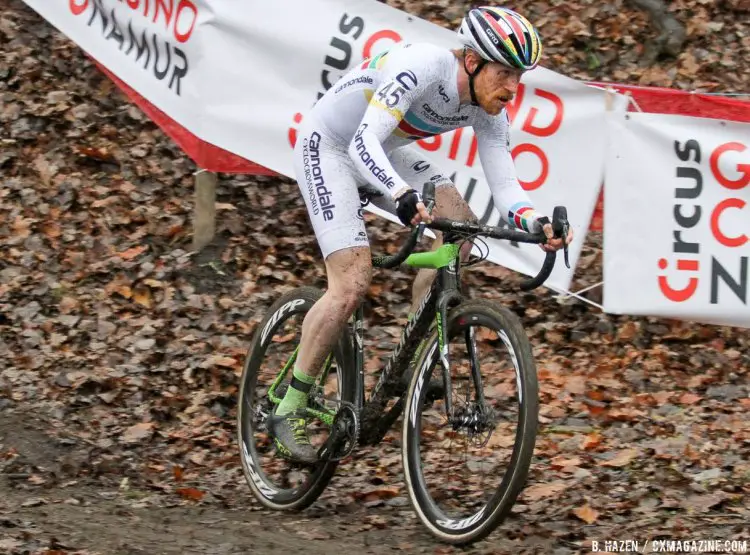
Klaas Vantornout won the Gingercross over Stephen Hyde at Namur this past season. © B. Hazen / Cyclocross Magazine
Vantornout holds an all-time 16-2 edge over Hyde in the Gingercross rivalry (h/t crossresults.com). However, the rivalry is starting to heat up, as Hyde’s two wins have come at this past season’s Hasselt and Flandriencross races. Unfortunately for Hyde, Vantornout recently announced he will be retiring at the end of the season, so this is his last season to achieve Gingercross glory.
Hyde also has his work cut out for him chasing Vantornout’s record of career achievement. The ginger, or pseduo-ginger, has taken the silver medal at the World Championships twice. First in 2010 in Tábor and most recently in the epic race against Sven Nys in Louisville in 2013.

Klaas Vantornout finished a close second behind Sven Nys at the 2013 World Championships in Louisville. © Nathan Hofferber
A late-comer to cyclocross who appears to be improving each race, Hyde still has time to chase his lofty dreams of Gingercross greatness. Vantornout has set the bar high, but as fans saw in Hartford, Hyde’s ability to grit out a championship finish with a flat tire and a dangling derailleur says the best parts of his story of the ginger’s ’cross greatness may yet to be written.
























